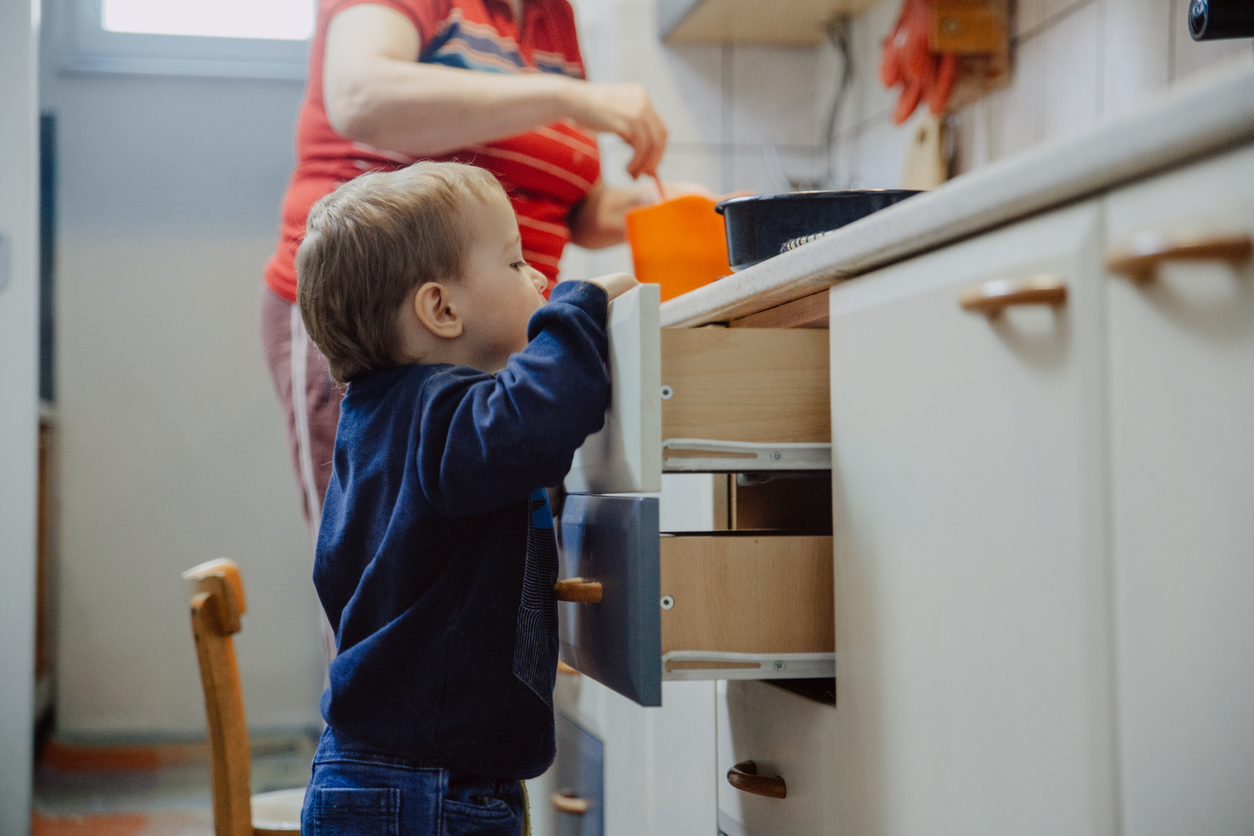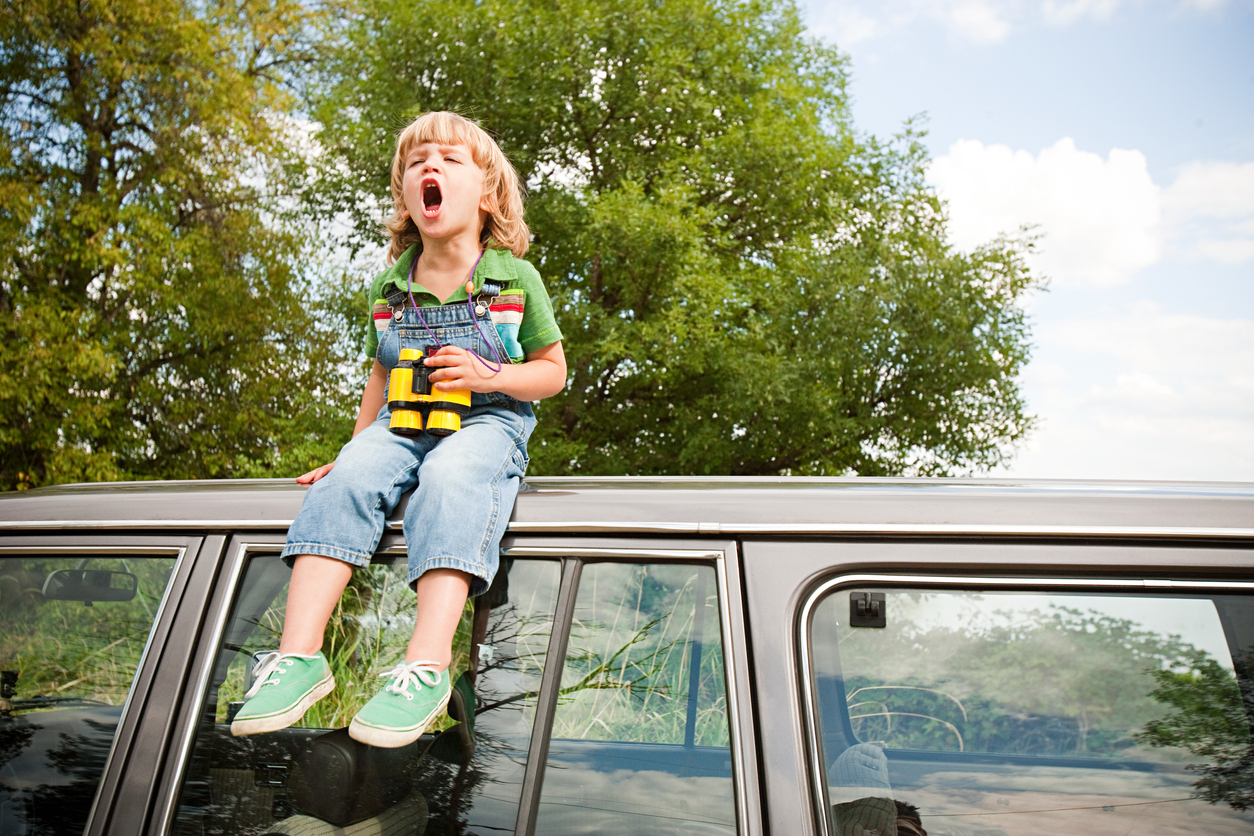How to Discipline a 1-Year-Old and Do They Really Understand It?

Age 1 is a turning point in your baby’s life. Most will be toddling along soon if they aren’t already.
They may say their first word and start to imitate the things that they see adults doing, such as sweeping the floor or using the toilet.
The first year of life was a period of rapid physical growth that slows down around age 1. Now their brain is developing at an amazing speed.
Toddlerhood is a time of wonder and discovery. But, it’s also a time when your child will begin to push boundaries or throw epic tantrums that you never thought they could.
Discipling a 1-year-old can feel overwhelming. They aren’t babies anymore, but they definitely need a different approach than older children.
Related: An Age-by-Age Guide to Setting Discipline Consequences for Kids
Ahead, we offer proactive advice for parenting 1-year-olds and how to address common challenges at this age.
Why 1-Year-Olds Push Boundaries
After your child turns 1, you will most likely notice that they are “naughty” more often. Whether it’s opening your desk drawer and pulling out all your important papers or refusing to stay in bed after bedtime after bedtime, these behaviors are not actually motivated by bad intent.
It’s really not about good behavior versus bad behavior, it’s about directing your child to meet their needs in appropriate ways.
Young toddlers have newly developed physical abilities, such as being able to walk or reach up to open a cabinet. They are naturally drawn to practicing their gross motor skills and their blossoming independence means that they can act on their curiosities.
Remember that curiosity and physical development are very good things! You want your child to be using their body and their mind.
So you don’t want to subdue their natural inclinations, but you do want to find positive ways to direct their energy. And, there are times when you need to set clear boundaries for safety or simply because you need a good night’s sleep.
The good news is, 1-year-old’s brains are also primed to learn rules and routines. They want to know what the limits are (that’s a big reason why they are testing them!). Now is the perfect time to teach them how things are done in your family. You can do this using positive discipline.
How to Set Boundaries with Young Children

Once you notice your 1-year-old pushing more boundaries, begin giving them some more independence. This is a great way to fulfill the need that young children have to contribute and be a part of the family.
For example, you might designate a drawer in your kitchen as theirs. Put a few simple toys in there, such as measuring cups or spoons.
You might also start giving them two shirts to choose from when getting dressed each morning. Allow them to slowly gain more independence in dressing and self-care.
When you give your toddler a limited amount of choices and a degree of independence that they can handle without too much frustration, you will find that their “naughty” behavior decreases. That’s because you are fulfilling their needs in a positive way.
But, there are going to be times when you simply cannot allow certain behaviors or you need to make a firm statement. This can be done in a positive and effective way as well which helps them develop self-control.
Use Positive Language to Enforce Rules and Set Limits
Set limits by redirecting and making a positive statement. If necessary, adjust the environment.
To help you understand what that means, let’s take an example. Imagine that your toddler is coming up to a group of preschoolers at the playground and reaching for the food in their lunches. First, you make a positive statement, which just means that you swap your no for a yes. Instead of “That food is not yours,” try, “Everyone touches their own food. Let’s get your lunch out.”
Getting your child’s lunch out is the redirection because they have shown that they might be interested in eating right now. If they aren’t hungry yet, that’s fine, but you remind them that everyone touches their own food.
Then you direct them somewhere else. Maybe they were curious and you can bring them over to touch and example rocks and mud instead of food that other people are trying to eat.
Change the Environment or Remove the Temptation
If you are having trouble redirecting your child, it’s time to readjust the environment. In this case, it would mean leaving the area where the other children are eating. Now the temptation and option to continue the behavior are gone. This is done matter-of-factly because it’s not a punishment, it’s simply your executive decision on what needs to be done.
Other times, adjusting the environment can mean putting an object out of sight or out of reach. Think of this as part of baby-proofing your child’s space. It can also mean removing yourself, such as in a situation where a child is pulling your hair and you have not been successful in getting them to stop.
How to Handle 1-Year-Old Tantrums
Tantrums, also called temper tantrums, are common in the toddler years. A tantrum is an extreme and prolonged emotional reaction that may include some combination of crying, yelling or thrashing of the body.
Tantrums usually happen because children do not feel heard or understood. Their verbal communication skills are limited at this age while their comprehension when listening to an adult speaks to them is high. Either they cannot get their point across or they don’t have the words to express their feelings so they act them out instead.
It’s really important to understand that tantrums are not misbehaviors in themselves. You can set a limit such as not allowing your toddler to pass a certain area or touch a certain object and they may throw a tantrum after you have enforced the boundaries and perhaps removed the object. But you don’t need to punish them for throwing the tantrum. It’s okay for them to have an emotional reaction. But you won’t be changing the original limit you have set.
We don’t want to teach kids that their emotions are not okay. We do want to gradually teach them to express themselves in an appropriate way, but we should not expect them to master that by age 1.
Here’s what you can do if your child throws a tantrum:
Reduce Harm to Your Child
Little ones can hurt themselves during their epic meltdowns. Swiftly move them somewhere safe like a bedroom and stay with them if that’s the best way to keep them physically safe. Holding or hugging them can be a way to keep them safe from injury too.
Reduce Harm to Others
Let’s be real – long bouts of screaming and crying grate on people’s nerves. As a parent, you do have some responsibility to protect others from either getting hurt or being simply irritated by a toddler tantrum. It’s simply good manners.
If you are in a grocery store or at the library, try your best to leave as soon as you can. If you are at a playdate, excuse yourself and step into the backyard (one bonus is that sometimes a change of scene is enough to stop a tantrum cold!).
You should also move your child if there is a chance for other children around them to be hurt or disturbed. But know that usually, other moms will be more understanding since they have been through this themselves.

Help Your Child with Their Big Feelings
Little kids have big feelings! Tantrums are a wonderful opportunity to guide your child and teach them how to process big feelings! Remember that the root of discipline is disciple, which means “to teach”. We are showing our little ones how to do life. And part of life is working through negative emotions.
Take your child into an area that is minimally stimulating like a dim bedroom. Open your arms and let them bury their little face into your T-shirt. Model deep breathing.
Don’t feel like you have to hold your child, because some kids do better without that physical contact. You can also simply sit with them and model calming strategies. Lie down and hold a blanket while taking slow breaths.
Related: The Ultimate List of Feelings to Help Kids Express Themselves
Once your child is calm, there is often a strong parental impulse to go back to what happened before the tantrum. You might want to say, “I know you are sad but Mommy’s office is off-limits.” But resist this urge!
Toddlers' brains don’t work like older children’s. You already did the teaching when you set the limit. Your child gets what you have communicated.
They just finished processing their emotional reaction to that limit. Now is not the time to bring the struggle back up! Let them move on and go do something fun together.
Enforcing Time-Outs for Toddlers
Time-outs can be used but it is very important to understand that it should not be used as a punishment, but rather as a tool. The American Academy of Pediatrics (AAP) advises against using discipline tactics that use shame.
When you isolate your child as a punishment, you shame them and break down your connection. That’s not going to teach them how to act. It’s just going to make them feel bad and learn to fear the consequence.
Instead, use a timeout in a positive way. Use it as a tool to help your toddler reset or calm down as needed. Keep timeouts short and stay calm and positive if you use them.
For example, if you have told your toddler to leave the bananas on the counter for later but they go and grab one, it’s okay to say, “Oh no, looks like you need a little time in your room!” That’s completely different than yelling at them and making timeout into a big punishment.
Note that the AAP recommends strictly against spanking or physical punishment of any kind, as well as yelling at or berating your child. Toddler discipline should be focused on teaching and positive reinforcement.
Toddler Sleep Regression: Causes and Treatment
You may notice some sleep issues creeping up around age 1. Your toddler may start screaming for you in the wee hours of the night, coming out of their room after bedtime, or stay up singing all through their nap time.
There are a few different reasons why your toddler’s sleep may change or become challenging around age 1. Let’s break down the possible causes of toddler sleep regression or discipline issues with sleep:
Mental Leap
As we mentioned, there is a lot going on cognitively during this second year of life. One important milestone that toddlers generally reach this year is learning to walk. During the period of time when they are just about to walk and shortly after they have begun, their brain is hyper-focused on this gross motor skill. They feel compelled to practice it.
This fixation may be so strong that it impacts sleep. Your child may wake up during the wee hours of the night to practice walking in their crib. This may not bother you but it can also lead to them deciding to cry out for you to come in and soothe them back to sleep when they are done.
Even if your child doesn’t wake up to physically practice walking, the high level of brain stimulation from this focus on learning to walk can make it harder for them to relax and drift off to sleep at night.
Time to Transition to One Nap a Day
Most kids are ready to transition to one long afternoon nap per day between 13 and 18 months. If sleep is impacted over a period of a few weeks and your toddler is already walking confidently, it may be time to change your daily routine.
You can do this in a few ways. One option is to push the first nap a little later each day until it merges with the second nap. You can also slowly shorten the first nap until it disappears.
Don’t be afraid to use an early bedtime during this transition. There should be no more than 4 and a half hours between your toddler’s last nap and their bedtime until your child is solidly on one nap.
Don’t, however, assume that your toddler is done napping. Most kids drop their nap around age 3.5 but it can range from 2.5 to age 5. A 1-year-old still needs a nap, as do most 2-year-olds. If they aren’t napping, try pushing their nap a bit later in the day.
Fixing or pushing through sleep issues can do wonders for your toddler’s behavior.
Limit Testing
Once your child learns to walk their world expands so much. They can cross a room quickly and efficiently and stand up to open doors or cabinets. Their brain development is expanding rapidly as their mobility helps them explore their world.
This also means that possibilities begin to appear to them. Once it’s bedtime, they realize that they can get up, walk across the room, and open their bedroom door. And just as you and your spouse sit down to watch some TV and relax together, they’re back to say hello.
Toddlers are experimenting. They want to know what will happen when they do different things. And they may want to know exactly what happens in the house after they are put to bed. This desire is totally natural, but most parents don’t want to encourage this behavior.
You may value your own time after the kid goes to bed, so you can recharge your own battery. Plus, toddlers need a solid night’s sleep to thrive and learn the following day.
How to Keep a 1-Year-Old in Bed

Here’s what you can do if your 1-year-old keeps popping out of their bedroom after you have laid them down:
-
You can lock their door
To do this, take the doorknob off and turn it around. Now you can lock it from the outside. The added benefit here is that they cannot lock themselves in (either accidentally or on purpose!).
It is perfectly fine to do this and it’s the fastest way to maintain your boundaries. However, some parents are not comfortable putting a lock on their child’s door. There is an alternative.
-
You can put them back to bed (again)
When they come out, silently take their hand and lead them back to their room. Then leave. The key here is not to engage any further than bringing them back. Your actions say, “It’s bedtime now.”
Disclaimer: Your child will probably come back out. If they do, you will need to repeat exactly the same reaction. They may come out many, many times. You have to do the same thing if you eventually want them to stop.
If you eventually do something different and start engaging with them, the problem will likely persist. Because now your actions say, “I will engage with you if you come out enough times.”
We promise that putting your child back to bed will work, it just may take many repetitions that may occur over a few nights.
How Nutrition Relates to Discipline
At age 1, there is a dramatic shift in your child’s nutritional needs. It’s the biggest change since they first started eating solid foods. If you have heard the saying “Food before one is just for fun,” understand that after one, food becomes a main source of nutrients for your child.
That saying is not quite true, but food before one is actually complementary to milk. Milk needs do not reduce, instead, a 7 or 8-month-old needs to eat some additional calories via solid foods on top of their milk intake.
During the second year of life, food becomes the main source of nutrition and milk becomes more of a supplement. Your child still needs milk, but the amount they need reduces.
If they are drinking breast milk, they can continue as desired. But if they have been drinking from bottles, it’s time to switch to a sippy cup or a regular cup. You will notice that they drink less milk this way and that’s fine.
At age 1, your child needs a variety of nutritional foods. Their diet should include fruits, vegetables, proteins, whole grains, and healthy fats. How does this play into discipline?
First, eating an appropriate diet primes your child’s mind and mood so which reduces many discipline issues in the first place. Next, mealtime is a great time to include some limited choices to help your child develop their will and their independence.
Common Discipline Issues at Mealtimes
Discipline issues are common at the table. One-year-olds may:
- Throw food
- Play with food
- Yell or cry at the table
- Attempt to leave the table
When Your Child Throws Food
For throwing food, the best thing to do is end the meal. You can say, “Oh you’re all done!” and take away their plate. First, you might be right! If this is true, remind them, “Tell me when you’re all done!”
Your child can say all done or sign it using American Sign Language (ASL) by turning two open palms from back to front. Another tip is to give them a small plate or dish to put any bits of food they don’t want for whatever reason. Teach this tip to your child’s other caregivers as well.
When Your Child Plays With Food
Playing with food can be a good way to discover new foods so you may not want to stop them. But you can place some limits. Try giving your child small amounts to start with and serving more if they ask. You can also teach them to use a napkin periodically while eating.
Yelling at the Table or Trying to Leave
Consider allowing your child to leave if they are done eating, or give them a small toy if they are done (not a screen!). If they are yelling tell them that we speak quietly at the table and use a quiet voice yourself.
We promise you that it is possible with the right discipline strategies. The more you understand your 1-year-old’s brain, the better you will be able to teach and guide them.
Ready to move onto the next stage of toddlerhood? Check out our advice for disciplining kids ages 2 to 6!